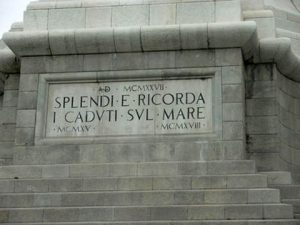Il Faro della Vittoria nasce da un’idea dell’architetto triestino Arduino Berlam che dopo la disfatta di Caporetto e la battaglia del Piave volle progettare un’opera imponente le cui funzioni comprendessero la commemorazione dei marinai caduti nella Prima Guerra Mondiale e la guida per la navigazione notturna nel Golfo di Trieste.
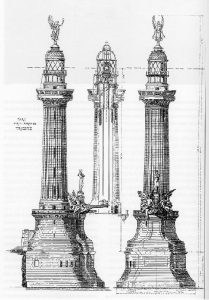 I lavori iniziarono nel 1923 e l’inaugurazione avvenne il 24 maggio 1927 alla presenza del Re Vittorio Emanuele III.
I lavori iniziarono nel 1923 e l’inaugurazione avvenne il 24 maggio 1927 alla presenza del Re Vittorio Emanuele III.
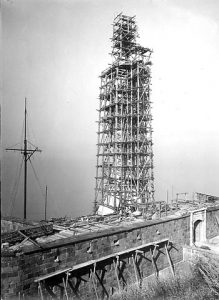
Il Faro è stato costruito sul sito Poggio di Gretta, a 60 metri sul livello del mare e con un grande basamento che ingloba il bastione
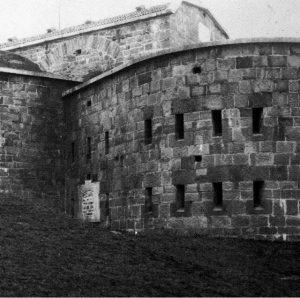
rotondo dell’ex Forte austriaco Kressich, completato nel 1854. Una delle strutture di difesa più importante del golfo e della città,fatto erigere dall’Impero Austro-Ungarico nel 1854, rimase efficiente per quasi trent’anni. 12 cannoni da 48 libbre lunghi, 5 da 48 libbre corti, 10 da 24 libbre, e 20 da 8 libbre, una galleria con feritoie per i moschetti, un fossato, un ponte levatoio, ampi e profondi sotterranei e il collegamento con Barcola, tutto questo costituiva il Forte Kressich.La struttura 68,85 metri di altezza è rivestita in pietra d’Orsera nella parte superiore e di pietra carsica di Gabria in quella inferiore.
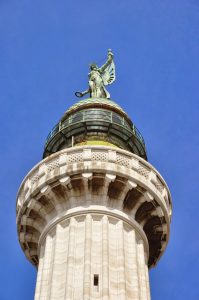
In cima alla colonna, la coffa,decorata a squame, sostenuta da un capitello e costruita a Napoli, contiene la gabbia,di bronzo e cristalli, della lanterna.
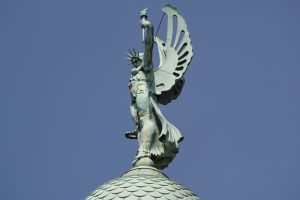
In cima alla cupola c’è la statua della Vittoria,alta 7,20 metri, dello scultore triestino Giovanni Mayer, costruita in rame e con un peso di 7 quintali, forgiata nella officina di Via Donato Bramante di Giacomo Srebot, dono degli armatori triestini.La particolarità della statua era che pur essendo di metallo riusciva ad essere elastica sotto le raffiche della bora e cioè a muovere le ali. Infatti il suo costruttore aveva inserito all’interno della statua un’asta d’acciaio dal diamentro di 20 centimetri munita di un forte manicotto all’altezza del torace e armata da braccia metalliche rotanti a spirale e su queste ultime fissò la statua che quindi venne dotata di un’anima di sostegno con un lungo e robusto piede fissato nella muratura.In questo modo la pressione esterna dovuta al forte vento veniva compensata dal movimento dei tiranti interni.Srebot aveva stabilito che ogni cinquant’anni bisognava intervenire all’interno della statua per regolare le ali e permettere un movimento equilibrato dell’intero sistema.Trieste racconta che un pò di anni fa si presentò ai guardiani del Faro un vecchietto che diceva di essere un collaboratore di Srebot e che era venuto per regolare il sistema interno della statua.I guardiani pensarono che era matto e lo allontanarono….Chissà…
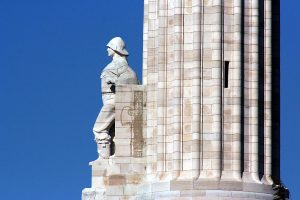
Alla base del faro, sopra il piedistallo, è collocata la statua del Marinaio ignoto (alta 8,60 metri) opera di Giovanni Mayer, realizzata dal maestro scalpellino Regolo Salandini con l’impiego di 100 tonnellate di pietra di Orsera e, sotto la statua,
è affissa l’ancora del cacciatorpediniere Audace, la prima nave da guerra italiana che, il 3 novembre 1918, raggiunse il porto di Trieste, ormeggiando al Molo San Carlo, da allora chiamato Molo Audace. L’ancora è stata donata il 3 febbraio 1924 dall’Ammiraglio Thaon de Revel ed la targa riporta scritto “Fatta prima d’ogni altra sacra dalle acque della gemma redenta il 3 novembre 1918”. Accanto all’ancora c’erano due proiettili dei cannoni della corazzata austriaca Viribus Unitis che ora sono posti a fianco dell’entrata. In totale il Faro della Vittoria ebbe un costo di 5.265.000 Lire.
Il monumento è dedicato ai marinai caduti nella Prima Guerra Mondiale, come testimonia la frase del poeta Gabriele D’Annunzio sul basamento “SPLENDI E RICORDA I CADUTI SUL MARE MCMXV – MCMXVIII”.
 I lavori iniziarono nel 1923 e l’inaugurazione avvenne il 24 maggio 1927 alla presenza del Re Vittorio Emanuele III.
I lavori iniziarono nel 1923 e l’inaugurazione avvenne il 24 maggio 1927 alla presenza del Re Vittorio Emanuele III.







